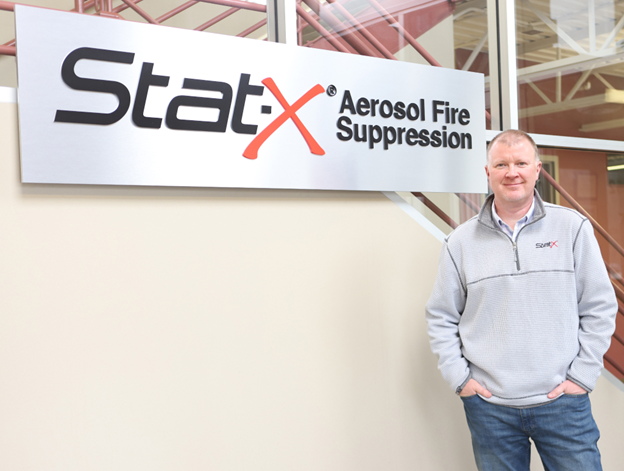Stat-X® CEO Underlines The Urgent Need For Sustainable Fire Suppression Solutions In The Energy Transition Era

Fire poses a significant threat to both property and human life in industrial safety. In the United States, industrial fires are roughly 6.2% due to electrical distribution and lighting equipment and 8% caused by heating equipment. Several industries commonly use special hazard fire suppression. However, driven by environmental concerns and the imperative of transitioning to sustainable practices, the methods employed to combat these hazards are slowly transforming.
Recent years have seen a growing recognition of the detrimental environmental impacts associated with traditional fire suppression methods. Products once commonplace in industrial settings, such as certain special hazard fire suppressants, are now facing extinction due to their prolonged atmospheric lifetimes and contribution to global warming. With regulatory measures tightening and public pressure mounting for eco-friendly alternatives, the stage is set for a shift in fire suppression technology.
One such transition is phasing down from hydrofluorocarbons (HFCs) which have long been used for fire protection systems. Once known as a replacement for ozone-depleting substances like halons, HFCs are now under scrutiny for their high global warming potential. Regulatory mandates, such as those enacted by the U.S. Environmental Protection Agency (EPA), are driving the reduction of HFC usage across various industries, including fire protection. "By and large, whether you agree or disagree with this phase down, it is happening due to the AIM Act [the American Innovation and Manufacturing Act] passed in 2020, which aims to reduce the usage by 85% by 2036. And people have to adapt and figure out what to do next," states Lance Harry, P.E., President and CEO of Fireaway Inc.
Another area of concern is the prevalence of per- and polyfluorinated substances (PFAS) in FK-5-1-12 fire suppression formulations. While initially touted as alternatives to HFCs, certain PFAS chemicals do have potential health and environmental hazards. As regulatory bodies scrutinize the use of PFAS compounds and a whole huge list of other chemicals, industries are grappling with the challenge of finding safer alternatives.
Amidst this landscape of transition and uncertainty, innovative solutions are emerging to address the pressing need for sustainable fire suppression. One such solution is Stat-X®, an advanced aerosol technology developed by a pioneering team committed to environmental stewardship and safety. Unlike traditional fire suppression agents, Stat-X boasts zero PFAS content and zero HFCs offering a greener alternative for safeguarding industrial spaces. "The Stat-X aerosol typically remains suspended for up to 20 minutes or more, significantly longer than most other agents, preventing propagation or reignition of the fire," states Mr. Harry. Its innovative design and application versatility make it well-suited for a wide range of hazards, from electrical equipment to renewable energy installations like wind turbines and energy storage systems. The company also plays a vital role in mitigating the risks associated with emerging technologies, such as lithium-ion battery storage.
Energy storage is a major component of renewable energy generation, as it allows for the economical viability of wind turbines and solar technologies. Solid storage technology is essential for these technologies, as they store energy until needed and then deliver it back to the grid. However, the application of energy storage is challenging due to the lithium-ion battery chemistries and the lack of suppression technology to prevent thermal runaway events. Stat-X aerosol technology, however, can mitigate the risk of thermal propagation from one cell to another, limiting the risk of major events versus smaller ones. Its low-maintenance design and minimal environmental footprint make it a compelling choice for businesses seeking to reduce their carbon footprint and regulatory compliance burden.
In addition to the environmental and safety benefits stated, energy professionals recognize the value of Stat-X through testing and real-world experience. Stat-X has been tested by multiple energy integrators verifying compliance with UL 9540, an important industry standard covering many aspects of Energy Storage System safety. Furthermore, one end user reported that Stat-X suppressed a fire event in an ESS facility, which was started by water leakage into the container. The Stat-X units were deployed when an electrical short caused a fire and initiated a thermal runaway event. The aerosol prevented further propagation of the thermal runaway and the ESS system was returned to service once the damaged batteries were replaced.
The Stat-X device is in a solid benign state and not pressurized even when ready to use. One just needs to ensure that the electrical signal and connections are good. This makes this device easier to maintain than pressurized cylinders, which require checking pressure for leakage and hydrostatic testing. The installation is also as simple as taking these thermally activated units, positioning a bracket on them, and attaching them to the sidewall or ceiling of the protected space. The slightly more complicated installation is the electrically activated units, where instead of putting a thermal activator on top of it, there are actually wires that come out, and the wires then get attached back to a control panel. Typically, this control panel would be directed by a type of smoke or heat detector. That is why this type of system is simpler and easier to install and maintain.
As regulatory pressures intensify with strides for green infrastructure and ESG 2030, the demand for eco-friendly fire suppression solutions will only continue to rise.
© Copyright IBTimes 2024. All rights reserved.




















